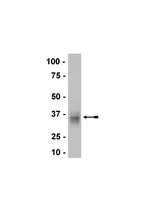Structure of the Ly49 family of natural killer (NK) cell receptors and their interaction with MHC class I molecules.
Dimasi, Nazzareno, et al.
Immunol. Res., 30: 95-104 (2004)
2004
Show Abstract
Natural killer (NK) cells are an essential component of the innate immunity toward tumors and virally infected cells. The function of NK cells is regulated by a precise balance between inhibitory and activating signals. These signals are mediated by NK cell receptors that bind either classical MHC class I molecules or their structural relatives such as MICA, ULBP, RAE-1, and H-60. Two separate families of NK cell receptors have been identified: the immunoglobulin-like family (KIR, LIR) and C-type lectin-like family (Ly49, NKG2D, and CD94/NKG2). Here we summarize the structure of Ly49 C-type lectin-like proteins hitherto solved (Ly49A, Ly49C and Ly49I) and their interaction with MHC class I molecules as determined by the co-crystal structure of Ly49A/H-2Dd and Ly49C/H-2Kb. | 15258313
 |
UL16 binding proteins.
Cao, Wei and He, Wei
Immunobiology, 209: 283-90 (2004)
2004
Show Abstract
According to present concepts, innate immunity plays an important role in tumor surveillance and immune modulation. The state of NK cells depends on the balance between inhibitory and activating signals from corresponding receptors. As one of the activating receptors, NKG2D recognises some self ligands such as MICA/B in human and Rae1 in mice, which is dissimilar to those toll-like receptors that recognise some pathogen-derived ligands. NKG2D is expressed not only on NK cells, but on gammadelta T cells, CD8+ alphabeta T cells in normal individuals and CD4+ alphabeta T cells in rheumatoid arthritis patients and plays a different role on respective cells. Whereas NKG2D can only function as a costimulatory receptor on CD8+ alphabeta T cells under the domination of alphabeta TCR in spite of a deficiency of costimulatory molecule CD28, NKG2D can directly activate NK cells even in the presence of inhibitory signals from MHC-I and corresponding receptor complexes. Experiments in mice have identified that alternative splicing produces two distinct NKG2D polypeptides that associate differentially with the DAP10 and DAP12 signaling subunits and that differential expression of these isoforms and of signaling proteins determines whether NKG2D only functions as a costimulatory receptor in the adaptive immune system (CD8+ T cells) or as both a primary recognition unit and a costimulatory receptor in the innate immune system (natural killer cells and macrophages). This review summarizes the research achievements in a new ligand family (UL16 binding proteins) of NKG2D in human and shows the possible prospects of ULBP function and application. | 15518340
 |
Roles of the NKG2D immunoreceptor and its ligands.
Raulet, David H
Nat. Rev. Immunol., 3: 781-90 (2003)
2003
Show Abstract
According to present concepts, innate immunity is regulated by receptors that determine danger levels by responding to molecules that are associated with infection or cellular distress. NKG2D is, perhaps, the best characterized receptor that is associated with responses to cellular distress, defined as transformation, infection or cell stress. This review summarizes recent findings that concern NKG2D, its ligands, its signalling properties and its role in disease, and provides a framework for considering how the induction of immune responses can be regulated by cellular responses to injury. | 14523385
 |








